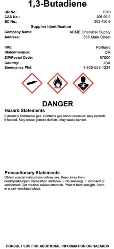
GHS Deadline Approaching Fast
Businesses and contractors continue to prepare for OSHA’s HazCom 2012 regulation.
- By Jordy Byrd
- Feb 01, 2015
Natural Structures is in the business of creating fun. The Baker City, Ore. design and manufacturing company has built custom water slides shaped like alligators and stainless steel slides, including one used inside Google's headquarters, since 1976.
Just like the curvature in its slides, Natural Structures' production was thrown off curve in 2012 when OSHA announced in 2012 revisions to the Hazard Communication Standard (HCS). Under the revision, which is known as HazCom 2012, employers must adhere to elements of an internationally recognized UN standard called the Globally Harmonized System for the Classification and Labeling of Chemicals (GHS). GHS describes specific tests to categorize hazards posed by a chemical and assigns label details for each hazard based on test results.
HazCom 2012 also requires chemical manufactures to send out a 16-section Safety Data Sheet (SDS), in place of the prior MSDS sheet, that provides detailed information regarding chemicals.
"The end of 2012 was kind of the initial, 'Now what?' phase," said Justin Emmons, safety coordinator with Natural Structures. "Last year, we really started buckling down, getting everyone trained and on the same page."
 Natural Structures is among an estimated 5 million workplaces in the United States affected by HazCom 2012. Emmons and his team of 50 employees represent a pin drop of the approximately 43 million employees exposed to hazardous chemicals in the workplace each day.
Natural Structures is among an estimated 5 million workplaces in the United States affected by HazCom 2012. Emmons and his team of 50 employees represent a pin drop of the approximately 43 million employees exposed to hazardous chemicals in the workplace each day.
The transition has been a laborious project since regulations came into effect on May 25, 2012, but the bottom of the slide is near. By June 1, 2015, all manufacturers, importers, and employers must comply with new label requirements and SDSs. No new chemicals may be produced or enter the country without proper labels after this point, although distributors were granted an extra six months to deplete existing inventory until Dec. 1, 2015.
Emmons and his team met the initial Dec. 1, 2013, training deadline by which employers were required to provide training on new label elements and SDS formats. The transition process has been tedious but necessary. "Teenagers think they’re invincible," Emmons said, "but adults can get into that mindset, too, with hazardous chemicals."
The Right to Know
Workers have a right to know whether the gaseous material produced in their day-to-day operations is a carcinogen or whether a drop of liquid will burn through their flesh. That's where safety coordinators such as Emmons step in. He coordinates monthly safety meetings, writes training programs, and facilitates new hires' safety training. He ensures his fabrication team properly handles metalworking fluids, that the powder coat department correctly uses cleaning solutions, and fiberglass resins are safely handled on job sites.
Like most workers, Emmons wears many hats. He is involved in the construction of 20-foot stainless steel slides installed across the globe.
That's where OSHA regulations take over. OSHA originally creating its HCS standard (29 CFR 1910.1200) in 1994. It's often called the Right-To-Know standard. HCS 1994 required chemical manufacturers and distributors to evaluate chemical hazards and provide information about health and physical hazards via MSDSs and labels, but it didn't prescribe a format for labeling. The lack of direction resulted in makeshift labeling and confusion. Natural Structures fell into this gray area.
"The labels were our biggest concern," Emmons said of that regulation. "Before, if we had a spray bottle filled with something, we just wrote on it with a Sharpie."
HazCom 2012 created a unified system. OSHA estimates the system will result in the prevention of 43 fatalities and 585 injuries and illnesses annually and will produce $250 million on an annualized basis due to reduced occupational risks.
Eliot Lapidus works to prevent such risks. He is a safety and health manager with the Associated General Contractors Oregon/Columbia Chapter. His team provides HazCom 2012 training to ensure the approximate 650 construction firms in his chapter have the information they need to use, control, store, and work safely with potentially hazardous materials.
Safety professionals have been flooded with questions surrounding the OSHA deadlines. Spreading the word can be an uphill battle. "The most common question is, 'Why?'" Lapidus said. "'Why should we bother with this?' We kind of had to break the ice with companies because they didn't understand the importance or consequences of new regulations. . . . Once they hear the whole story, it's easier to swallow."
These revisions are not without a learning curve. Hazard communication continues to be OSHA's second most-cited violation. In 2014, OSHA cited 6,148 Hazard Communication violations. Top sections that were cited included:
1. Employee information and training
2. Developing, implementing, and maintaining a written Hazard Communication program
3. Labels on shipped containers
4. Employee training on new label elements and SDS formats
Emmons said despite the learning curve, training updates have already spurred constructive conversations in his facility. "Guys have been asking me if they need to wear a respirator or gloves when handling certain material—even asking about wearing extra safety gear," he said. "The requirements for handling materials haven’t necessarily changed, but it's opened up a dialogue, and workers are more confident about what they’re working with."
Label Requirements
Labels have become comprehensive. Workers will soon know with a glance not only whether a chemical is hazardous, but how hazardous it is based upon classification standards, how to handle it, and how to protect themselves.
HazCom 2012 now requires the following elements on labels:
- Name, address, and telephone number of the chemical manufacturer, importer, or other responsible party are listed.
- Product Identifier outlines how the hazardous chemical is identified. This can be the chemical name, code number, or batch number. The manufacturer, importer, or distributor can decide the appropriate product identifier.
- Signal Words are used to indicate the level of severity of the hazard and alert the reader to a potential hazard on the label. There are only two words used as signal words, "Danger" and "Warning." Within a specific hazard class, "Danger" is used for the more severe hazards and "Warning" is used for the less severe hazards. There will only be one signal word on the label, no matter how many hazards a chemical may have.
- Hazard Statements describe the nature of the hazard(s) of a chemical, including, where appropriate, the degree of hazard. All of the applicable hazard statements must appear on the label.
- Precautionary Statements describe recommended measures that should be taken to minimize or prevent adverse effects resulting from exposure to the hazardous chemical or improper storage or handling. There are four types of precautionary statements: prevention (to minimize exposure); response (in case of accidental spillage or exposure during emergency response, and first aid); storage; and disposal.
- Pictograms are graphic symbols used to communicate specific information about the hazards of a chemical. On hazardous chemicals being shipped or transported from a manufacturer, importer, or distributor, the required pictograms consist of a red square frame set at a point with a black hazard symbol on a white background, sufficiently wide to be clearly visible. A square red frame set at a point without a hazard symbol is not a pictogram and is not permitted on the label. While GHS uses a total of nine pictograms, OSHA only will enforce the use of eight.
Commonly used labels such as the National Fire Protection Association (NFPA Diamond) and Hazardous Materials Identification System (HMIS) may continue to be used in workplaces so long as the information doesn't contradict HazCom 2012 labels; however, these labels cannot stand alone because they no longer satisfy OSHA's labeling requirements.
Natural Structures and other employers are responsible for maintaining these labels on containers, including tanks, totes, and drums, and must relabel the container if the information has been removed or defaced.
Emmons purchased a thermal transfer label printer to get the job done. He's created labels used on everything from reduced containers to spray bottles filled with cleaning solutions. "The moment labeling requirements were brought up, we started researching printers," he said. "I wasn't sure how we were going to get the pictogram and all the descriptions on the labels made. Now we print what we need, when we need it."
Waiting Game
Today Emmons waits. He and countless other safety coordinators await the arrival of GHS-complaint SDSs from the respective 90,000 hazardous chemical manufactures nationwide. Natural Structures will receive more than 300 SDSs in the coming months before the June 1, 2015 deadline. "We are expecting to be flooded with them this year. . . . Everything's got one, and they all need [to be] copied and filed," he said.
He uses his printer to prep labels for future use and trains new employees—some are people with 30 years on the job, others are straight out of high school—regarding new labeling and SDS requirements. This labor is almost impossible to quantify in dollars. "We've always been concerned about time, worried about man-hours taken away from production," Emmons said.
OSHA estimates the revised Hazard Communications Standard will cost the United States $201 million on an annualized basis. The four major expenditures include:
- $22.5 million: Classifying chemical hazards in accordance with GHS criteria and revising SDSs and labels to meet new format and content requirements
- $95.4 million: Training employees to become familiar with new warning symbols and the revised SDS sheets
- $59 million: Allowing management to become familiar with the new GHS system and to engage in other management-related activities that may be necessary for industry’s adoption of GHS
- $24.1 million: Printing packaging and labels for hazardous chemicals in color
Companies and safety professionals such as Lapidus are still navigating the HazCom 2012 revisions, and they know the door is open for more interpretation. The end goal is worth it. "It's going to take some time to adjust," Lapidus said, "but it's the same battle for all of us. We want to make a safer working environment. Compliance isn't our number one objective, it's the genuine safety of the people who are working."
Emmons said Natural Structures is prepared for the June 1, 2015, compliance deadline. Right now, it's business as usual crafting curlicue water slides. Despite the initial investment, Emmons said, his company has handled the transition in stride. "You just gotta keep a cool head about it," he said, laughing. "The transition has been a little less painful than we anticipated. . . . And, most importantly, it's good for people to be more aware of the chemicals they are using every day."
References
1. https://www.osha.gov/dsg/hazcom/side-by-side.html
2. https://www.osha.gov/publications/osha3514.pdf
This article originally appeared in the February 2015 issue of Occupational Health & Safety.